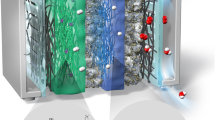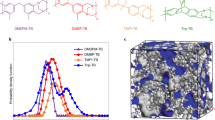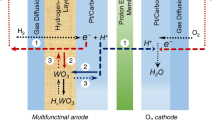Abstract
With the rapid growth and development of proton-exchange membrane fuel cell (PEMFC) technology, there has been increasing demand for clean and sustainable global energy applications. Of the many device-level and infrastructure challenges that need to be overcome before wide commercialization can be realized, one of the most critical ones is increasing the PEMFC power density, and ambitious goals have been proposed globally. For example, the short- and long-term power density goals of Japan’s New Energy and Industrial Technology Development Organization are 6 kilowatts per litre by 2030 and 9 kilowatts per litre by 2040, respectively. To this end, here we propose technical development directions for next-generation high-power-density PEMFCs. We present the latest ideas for improvements in the membrane electrode assembly and its components with regard to water and thermal management and materials. These concepts are expected to be implemented in next-generation PEMFCs to achieve high power density.
This is a preview of subscription content, access via your institution
Access options
Access Nature and 54 other Nature Portfolio journals
Get Nature+, our best-value online-access subscription
$29.99 / 30 days
cancel any time
Subscribe to this journal
Receive 51 print issues and online access
$199.00 per year
only $3.90 per issue
Buy this article
- Purchase on Springer Link
- Instant access to full article PDF
Prices may be subject to local taxes which are calculated during checkout




Similar content being viewed by others
References
Jewell, J. et al. Limited emission reductions from fuel subsidy removal except in energy-exporting regions. Nature 554, 229–233 (2018).
Staffell, I. et al. The role of hydrogen and fuel cells in the global energy system. Energy Environ. Sci. 12, 463–491 (2019).
Itaoka, K., Saito, A. & Sasaki, K. Public perception on hydrogen infrastructure in Japan: Influence of rollout of commercial fuel cell vehicles. Int. J. Hydrogen Energy 42, 7290–7296 (2017).
Eberle, U., Müller, B. & Helmolt, R. Fuel cell electric vehicles and hydrogen infrastructure: status 2012. Energy Environ. Sci. 5, 8780–8798 (2012).
Cano, Z. P. et al. Batteries and fuel cells for emerging electric vehicle markets. Nat. Energy 3, 279–289 (2018).
Gröger, O., Gasteiger, H. A. & Suchsland, J. P. Electromobility: batteries or fuel cells? J. Electrochem. Soc. 162, A2605–A2622 (2015). This review compares batteries and fuel cells for automotive applications, suggesting that the high energy density of fuel cells makes them suitable for heavy-duty and long-distance transportation.
Hu, X. et al. Battery warm-up methodologies at subzero temperatures for automotive applications: recent advances and perspectives. Pror. Energy Combust. Sci. 77, 100806 (2020).
Introducing the all-new Toyota MIRAI. Toyota Europe Newsroom https://newsroom.toyota.eu/introducing-the-all-new-toyota-MIRAI/ (2020).
Wilson, A., Kleen, G. & Papageorgopoulos, D. Fuel Cell System Cost–2017. DOE Hydrogen and Fuel Cells Program Record 17007. https://www.hydrogen.energy.gov/pdfs/17007_fuel_cell_system_cost_2017.pdf (DOE Fuel Cell Technologies Office, 2017).
Wang, Y. et al. Fundamentals, materials, and machine learning of polymer electrolyte membrane fuel cell technology. Energy AI 1, 100014 (2020).
Frendo, O. et al. Data-driven smart charging for heterogeneous electric vehicle fleets. Energy AI 1, 100007 (2020).
Jin, D. & Jiao, K. Charging infrastructure intellectualization and future of different automotive powertrains. Joule 4, 1634–1636 (2020).
Harrison, M. Toyota electrification strategy in Europe today and tomorrow. Toyota Motor Europe https://www.autonews.com/assets/pdf/ane-congress/presentations2019/matthew_harrison.pdf (2019).
Full specs of Toyota MIRAI 2021. Toyota USA https://www.toyota.com/MIRAI/features/mileage_estimates/3002/3003 (2020).
Konno, N., Mizuno, S. & Nakaji, H. Development of compact and high-performance fuel cell stack. SAE Mobilus 4, 123–129 (2015).
Amamiya, I. & Tanaka, S. Current topics proposed by PEFC manufacturers, etc. – current status and topics of fuel cells for FCV. In Hydrogen, Fuel Cell Project Evaluation, and Issue Sharing Week (Japan New Energy and Industrial Technology Development Organization, 2019); available at https://www.nedo.go.jp/content/100895101.pdf (in Japanese).
Volume manufacturing of PEM FC stacks for transportation and in-line quality assurance (European Commission, 2019); https://cordis.europa.eu/project/id/671465
Fuel Cells and Hydrogen 2 Joint Undertaking (FCH 2 JU). 2019 annual work plan and budget (FCH 2 JU, 2018); https://ec.europa.eu/research/participants/data/ref/h2020/other/wp/jtis/h2020-wp19-fch_en.pdf
Ozden, A., Shahgaldi, S., Li, X. & Hamdullahpur, F. A review of gas diffusion layers for proton exchange membrane fuel cells – with a focus on characteristics, characterization techniques, materials and designs. Pror. Energy Combust. Sci. 74, 50–102 (2019).
Gerteisen, D. & Sadeler, C. Stability and performance improvement of a polymer electrolyte membrane fuel cell stack by a laser perforation of gas diffusion layers. J. Power Sources 195, 5252–5257 (2010).
Tian, X. et al. Engineering bunched Pt-Ni alloy nanocages for efficient oxygen reduction in practical fuel cells. Science 366, 850–856 (2019).
Chong, L. et al. Ultralow-loading platinum-cobalt fuel cell catalysts derived from imidazolate frameworks. Science 362, 1276–1281 (2018).
Chen, C. et al. Highly crystalline multimetallic nanoframes with three-dimensional electrocatalytic surfaces. Science 343, 1339–1343 (2014).
Li, M. et al. Ultrafine jagged platinum nanowires enable ultrahigh mass activity for the oxygen reduction reaction. Science 354, 1414–1419 (2016). This study achieves high specific and mass activity using ultrafine jagged platinum nanowires for oxygen reduction, suggesting a promising approach to realizing high-current-density fuel cells.
Huang, X. et al. High-performance transition metal–doped Pt3Ni octahedra for oxygen reduction reaction. Science 348, 1230–1234 (2015).
Ott, S. et al. Ionomer distribution control in porous carbon-supported catalyst layers for high-power and low Pt-loaded proton exchange membrane fuel cells. Nat. Mater. 19, 77–85 (2020). This study shows that N-doped carbon supports can improve ionomer distribution in the catalyst layer, providing an important path to next-generation high-power-density fuel cells.
Yarlagadda, V. et al. Boosting fuel cell performance with accessible carbon mesopores. ACS Energy Lett. 3, 618–621 (2018).
Poojary, S., Islam, M. N., Shrivastava, U. N., Roberts, E. P. L. & Karan, K. Transport and electrochemical interface properties of ionomers in low-Pt loading catalyst layers: effect of ionomer equivalent weight and relative humidity. Molecules 25, 3387 (2020).
Yoon, K. R. et al. Mussel-inspired polydopamine-treated reinforced composite membranes with self-supported CeOx radical scavengers for highly stable PEM fuel cells. Adv. Funct. Mater. 29, 1806929 (2019).
Park, C. H. et al. Nanocrack-regulated self-humidifying membranes. Nature 532, 480–483 (2016). This study develops self-humidifying membranes with surface nanocrack coatings, providing an alternative solution for membranes that tolerate low-humidity conditions.
Liu, X. et al. Magnetic field alignment of stable proton-conducting channels in an electrolyte membrane. Nat. Commun. 10, 842 (2019). This study develops composite membranes with through-plane-aligned proton channels, showing that thus oriented channels improve proton conductivity and durability, and that microporous channels strongly retain water.
Tanaka, S., Bradfield, W. W., Legrand, C. & Malan, A. G. Numerical and experimental study of the effects of the electrical resistance and diffusivity under clamping pressure on the performance of a metallic gas-diffusion layer in polymer electrolyte fuel cells. J. Power Sources 330, 273–284 (2016).
Tanaka, S. & Shudo, T. Corrugated mesh flow channel and novel microporous layers for reducing flooding and resistance in gas diffusion layer-less polymer electrolyte fuel cells. J. Power Sources 268, 183–193 (2014).
Lee, J., Hinebaugh, J. & Bazylak, A. Synchrotron X-ray radiographic investigations of liquid water transport behavior in a PEMFC with MPL-coated GDLs. J. Power Sources 227, 123–130 (2013).
Li, D. et al. Functional links between Pt single crystal morphology and nanoparticles with different size and shape: the oxygen reduction reaction case. Energy Environ. Sci. 7, 4061–4069 (2014).
Karan, K. PEFC catalyst layer: recent advances in materials, microstructural characterization, and modeling. Curr. Opin. Electrochem. 5, 27–35 (2017).
Kim, Y. S. & Pivovar, B. S. The membrane–electrode interface in PEFCs. J. Electrochem. Soc. 157, B1616 (2010).
Holdcroft, S. Fuel cell catalyst layers: a polymer science perspective. Chem. Mater. 26, 381–393 (2014).
Yin, Y. et al. Ionomer migration within PEMFC catalyst layers induced by humidity changes. Electrochem. Commun. 109, 106590 (2019).
Crowtz, T. C. & Dahn, J. R. Screening bifunctional Pt based NSTF catalysts for durability with the rotating disk electrode: The effect of Ir and Ru. J. Electrochem. Soc. 165, F854–F862 (2018).
Steinbach, A. J. et al. Ultrathin film NSTF ORR electrocatalysts for PEM fuel cells. ECS Trans. 80, 659–676 (2017).
Steinbach, A. Final Technical Report for Project Entitled Highly Active, Durable, and Ultra-Low PGM NSTF Thin Film ORR Catalysts and Support. Technical Report DOE-3M-0007270 (US Department of Energy, 2020).
Murata, S., Imanishi, M., Hasegawa, S. & Namba, R. Vertically aligned carbon nanotube electrodes for high current density operating proton exchange membrane fuel cells. J. Power Sources 253, 104–113 (2014).
Kraytsberg, A. & Ein-Eli, Y. Review of advanced materials for proton exchange membrane fuel cells. Energy Fuels 28, 7303–7330 (2014).
Wang, Y., Ruiz Diaz, D. F., Chen, K. S., Wang, Z. & Adroher, X. C. Materials, technological status, and fundamentals of PEM fuel cells – A review. Mater. Today 32, 178–203 (2020).
Zamel, N. & Li, X. Effect of contaminants on polymer electrolyte membrane fuel cells. Pror. Energy Combust. Sci. 37, 292–329 (2011).
Kinumoto, T. et al. Durability of perfluorinated ionomer membrane against hydrogen peroxide. J. Power Sources 158, 1222–1228 (2006).
Pearman, B. P. et al. The chemical behavior and degradation mitigation effect of cerium oxide nanoparticles in perfluorosulfonic acid polymer electrolyte membranes. Polym. Degrad. Stabil. 98, 1766–1772 (2013).
Durante, V. A. & Delaney, W. E. Highly stable fuel cell membranes and methods of making them. US patent 7,989,115 B2 (2011).
Zaidi, S. M. J., Mikhailenko, S. D., Robertson, G. P., Guiver, M. D. & Kaliaguine, S. Proton conducting composite membranes from polyether ether ketone and heteropolyacids for fuel cell applications. J. Membr. Sci. 173, 17–34 (2000).
Miyatake, K., Chikashige, Y., Higuchi, E. & Watanabe, M. Tuned Polymer electrolyte membranes based on aromatic polyethers for fuel cell applications. J. Am. Chem. Soc. 129, 3879–3887 (2007).
Yin, Y. et al. Synthesis and properties of highly sulfonated proton conducting polyimides from bis(3-sulfopropoxy)benzidine diamines. J. Mater. Chem. 14, 1062–1070 (2004).
Wu, S. et al. The direct synthesis of wholly aromatic poly(p-phenylene)s bearing sulfobenzoyl side groups as proton exchange membranes. Polymer 47, 6993–7000 (2006).
Rikukawa, M. & Sanui, K. Proton-conducting polymer electrolyte membranes based on hydrocarbon polymers. Prog. Polym. Sci. 25, 1463–1502 (2000).
Smitha, B., Sridhar, S. & Khan, A. A. Solid polymer electrolyte membranes for fuel cell applications—a review. J. Membr. Sci. 259, 10–26 (2005).
Miyake, J. et al. Design of flexible polyphenylene proton-conducting membrane for next-generation fuel cells. Sci. Adv. 3, eaao0476 (2017).
Kang, N. R., Pham, T. H. & Jannasch, P. Polyaromatic perfluorophenylsulfonic acids with high radical resistance and proton conductivity. ACS Macro Lett. 8, 1247–1251 (2019).
Adamski, M. et al. Molecular branching as a simple approach to improving polymer electrolyte membranes. J. Membr. Sci. 595, 117539 (2020).
Lee, K.-S., Spendelow, J. S., Choe, Y.-K., Fujimoto, C. & Kim, Y. S. An operationally flexible fuel cell based on quaternary ammonium-biphosphate ion pairs. Nat. Energy 1, 16120 (2016).
Lee, S. Y. et al. Morphological transformation during cross-linking of a highly sulfonated poly(phenylene sulfide nitrile) random copolymer. Energy Environ. Sci. 5, 9795–9802 (2012).
Liu, X. et al. Oriented proton-conductive nano-sponge-facilitated polymer electrolyte membranes. Energy Environ. Sci. 13, 297–309 (2020).
Zhang, X. et al. A paradigm shift for a new class of proton exchange membranes with ferrocyanide proton-conducting groups providing enhanced oxidative stability. J. Membr. Sci. 616, 118536 (2020).
Steele, B. C. H. & Heinzel, A. Materials for fuel-cell technologies. Nature 414, 345–352 (2001).
Taherian, R. A review of composite and metallic bipolar plates in proton exchange membrane fuel cell: materials, fabrication, and material selection. J. Power Sources 265, 370–390 (2014); retraction 265, 370–390 (2014).
Office of Energy Efficiency & Renewable Energy. DOE Technical targets for polymer electrolyte membrane fuel cell components https://www.energy.gov/eere/fuelcells/doe-technical-targets-polymer-electrolyte-membrane-fuel-cell-components#bipolarplate (accessed 3 July 2021).
Wang, C. & Cullen, D. A. Novel structured metal bipolar plates for low cost manufacturing https://www.hydrogen.energy.gov/pdfs/review20/fc105_wang_2020_p.pdf (TreadStone Technologies Inc., 2020).
James, B. D., Huya-Kouadio, J. M., Houchins, C. & DeSantis, D. A. Mass production cost estimation of direct H2 PEM fuel cell systems for transportation applications: 2018 update https://www.energy.gov/sites/default/files/2020/02/f71/fcto-sa-2018-transportation-fuel-cell-cost-analysis-2.pdf (Strateg. Anal. Inc., 2018).This study evaluates the manufacturing cost of fuel cells from individual components to transportation systems. The paper supports the discussion on bipolar plates presented in this Perspective.
Adrianowycz, O. et al. Next Generation Bipolar Plates for Automotive PEM Fuel Cells. Report DE-FC36-07GO17012 (Office of Scientific & Technical Information, 2010); https://digital.library.unt.edu/ark:/67531/metadc927369/
Saito, N., Kikuchi, H. & Nakao, Y. New Fuel Cell Stack for FCX Clarity. Honda R&D Technical Review 21, 1 (Honda, 2009).
Inoue, M., Saito, N. & Uchibori, K. Next-Generation Fuel Cell Stack for Honda FCX. Honda R&D Technical Review 17, 2 (Honda, 2005).
Kikuchi, H., Kaji, H., Nishiyama, T., Okonogi, D. & Harata, H. Development of New FC Stack for Clarity Fuel Cell. Honda R&D Technical Review 28, 2 (Honda, 2016).
Kimura, Y., Oyama, S., Giga, A. & Okonogi, D. Development of New FC Separator for Clarity Fuel Cell. Honda R&D Technical Review 29, 2 (Honda, 2017).
Wilberforce, T. et al. A comprehensive study of the effect of bipolar plate (BP) geometry design on the performance of proton exchange membrane (PEM) fuel cells. Renew. Sustain. Energy Rev. 111, 236–260 (2019).
Dubau, L. et al. A review of PEM fuel cell durability: materials degradation, local heterogeneities of aging and possible mitigation strategies. WIREs Energy Environ. 3, 540–560 (2014).
Jiao, K. & Li, X. Water transport in polymer electrolyte membrane fuel cells. Pror. Energy Combust. Sci. 37, 221–291 (2011).
Zhang, G. & Kandlikar, S. G. A critical review of cooling techniques in proton exchange membrane fuel cell stacks. Int. J. Hydrogen Energy 37, 2412–2429 (2012).
Khandelwal, M. & Mench, M. M. Direct measurement of through-plane thermal conductivity and contact resistance in fuel cell material. J. Power Sources 161, 1106–1115 (2006).
Antunes, R. A., Oliveira, M. C. L., Ett, G. & Ett, V. Corrosion of metal bipolar plates for PEM fuel cells: a review. Int. J. Hydrogen Energy 35, 3632–3647 (2010).
Saiki, K. Strength Design Method of Metallic Separator for Fuel Cell. Honda R&D Technical Review 29, 1 (Honda, 2017).
Norley, J. Graphite-based bipolar plates for PEM motive fuel cell applications. In DOE Bipolar Plates Workshop (GrafTech Int. Holdings Ltd, 2017); https://www.energy.gov/sites/prod/files/2017/05/f34/fcto_biploar_plates_wkshp_norley.pdf
Wu, J. et al. A review of PEM fuel cell durability: degradation mechanisms and mitigation strategies. J. Power Sources 184, 104–119 (2008).
Wang, Y. Porous-media flow fields for polymer electrolyte fuel cells. J. Electrochem. Soc. 156, B1124 (2009).
Srouji, A. K., Zheng, L. J., Dross, R., Turhan, A. & Mench, M. M. Ultra-high current density water management in polymer electrolyte fuel cell with porous metallic flow field. J. Power Sources 239, 433–442 (2013).
Yuan, W., Tang, Y., Yang, X. & Wan, Z. Porous metal materials for polymer electrolyte membrane fuel cells – a review. Appl. Energy 94, 309–329 (2012).
Park, J. E. et al. Gas diffusion layer/flow-field unified membrane-electrode assembly in fuel cell using graphene foam. Electrochim. Acta 323, 134808 (2019). This study proposes an integrated design of the gas diffusion layer and flow field with boosted fuel cell performance, demonstrating that such a design is promising for increasing the power density.
Acknowledgements
This research was supported by the China-UK International Cooperation and Exchange Project (Newton Advanced Fellowship), supported by the National Natural Science Foundation of China (grant number 51861130359), the UK Royal Society (grant number NAF\R1\180146), UK EPSRC (grant number EP/S000933/1), and the Natural Science Foundation of Tianjin (China) for Distinguished Young Scholars (grant number 18JCJQJC46700).
Author information
Authors and Affiliations
Contributions
K.J., J.X., Q.D., Z.H. and M.D.G. conceived the idea for the study. All authors contributed to the writing and commented on the manuscript. K.J., Z.B., B.X., B.W., Y.Z., L.F. and M.D.G. contributed to the preparation of the figures.
Corresponding authors
Ethics declarations
Competing interests
The authors declare no competing interests.
Additional information
Peer review information Nature thanks Shangfeng Du, Julien Durst and the other, anonymous, reviewer(s) for their contribution to the peer review of this work.
Publisher’s note Springer Nature remains neutral with regard to jurisdictional claims in published maps and institutional affiliations.
Supplementary information
Supplementary Information
This file contains Supplementary Information, including Supplementary Tables 1-2 and additional references.
Rights and permissions
About this article
Cite this article
Jiao, K., Xuan, J., Du, Q. et al. Designing the next generation of proton-exchange membrane fuel cells. Nature 595, 361–369 (2021). https://doi.org/10.1038/s41586-021-03482-7
Received:
Accepted:
Published:
Issue Date:
DOI: https://doi.org/10.1038/s41586-021-03482-7
This article is cited by
-
An operationally broadened alkaline water electrolyser enabled by highly stable poly(oxindole biphenylene) ion-solvating membranes
Nature Energy (2024)
-
Significant enhancement of proton conductivity in solid acid at the monolayer limit
Nature Communications (2024)
-
Phosphate-grafted polyethyleneimine-induced multifunctional cerium oxide as an antioxidant for simultaneously enhancing the proton conductivity and durability of proton exchange membranes
Advanced Composites and Hybrid Materials (2024)
-
Effect of surface roughness on contact resistance and electrochemical corrosion behavior of 446 stainless steel in simulated anode environments for proton exchange membrane fuel cell
Journal of Solid State Electrochemistry (2024)
-
A dual-functional cuprum coordination framework for high proton conduction and electrochemical dopamine detection
Microchimica Acta (2024)
Comments
By submitting a comment you agree to abide by our Terms and Community Guidelines. If you find something abusive or that does not comply with our terms or guidelines please flag it as inappropriate.



